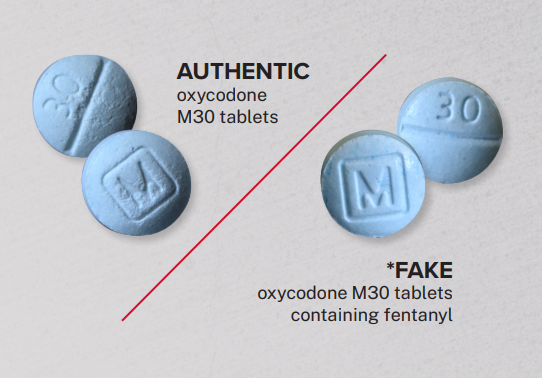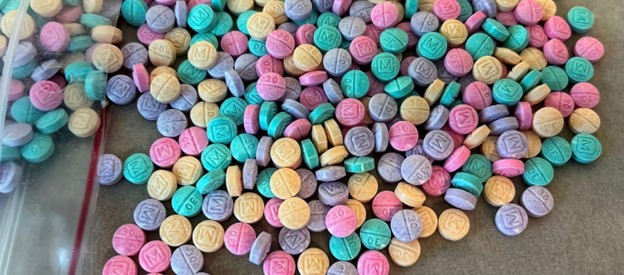
Stay vigilant and take steps to help curb fatal and nonfatal drug overdoses.
Fentanyl Remains Top Cause of Overdoses
Fentanyl is the primary opioid responsible for fatal and nonfatal overdoses in the Fairfax Health District. Since 2022, more than 95% of all opioid overdose deaths have involved fentanyl. Information on local overdose trends is available in the Fairfax Opioid Overdose Dashboard.

Fentanyl is an opioid that is a common substitute or cutting agent in illicit narcotics such as cocaine, heroin, MDMA (also known as ecstasy or molly), as well as counterfeit pills. According to the U.S. Drug Enforcement Administration (DEA), 2 milligrams of fentanyl – the amount on the tip of the pencil in the photo – is a potentially deadly dose. In 2025, the DEA seized over 39 million fentanyl pills and 8,070 pounds of fentanyl powder, representing over 300 million deadly doses.

Counterfeit pills laced with fentanyl can look the same as authentic pills, making it almost impossible to know whether a pill has a deadly dose of fentanyl or not.


Rainbow fentanyl – or fentanyl pills and powder that come in a variety of bright colors, shapes, and sizes – is also an emerging national concern, according to the U.S. DEA.

Signs of Opioid Overdose
- Face is pale or clammy
- Breathing is infrequent or has stopped
- Deep snoring or gurgling (death rattle)
- Unresponsive to any stimuli
- Slow or no heart rate and/or pulse
- Bluish purple, or ashen skin color
- Fingernails turn blue or blue-black
Fairfax County's Opioid Response
Our work to address the opioid epidemic is led by the Opioid and Substance Use Task Force, which was created in 2017. The FY 26- FY 28 Opioid Response Plan includes about 40 opioid-related programs/activities focused on reducing opioid-related overdoses and deaths in our community.
View this infographic highlighting the broad range and reach of this work.
There has been a significant focus on enhancing youth prevention, treatment, harm reduction and recovery programs/activities. These efforts include:
- Expanding naloxone availability
- Providing community presentations and messages
- Updating an opioid communications toolkit with messages in English and Spanish tailored to youth
- Expanding youth treatment capacity for medication for opioid use disorder and bringing youth detoxification (withdrawal management)/residential treatment services to Northern Virginia.
More information on our opioid response is available online.
What Can I Do?
This is a communitywide problem and requires a comprehensive approach to prevent future overdoses and to connect people experiencing opioid and substance misuse to treatment and support services.
- Talk with your youth and other loved ones who are impacted by substance misuse about the dangers associated with drug use. Have a short, judgment-free talk about stress, mental health, peer pressure and substance use.
- Get some quick tips on how to have these conversations from:
- FCPS' Become Unskippable campaign;
- the New Drug Talk (English/Spanish); and
- the U.S. Substance Abuse and Mental Health Services Administration.
- Sign up for a “Talk. They Hear You” training provided by our Community Services Board.
- Get some quick tips on how to have these conversations from:
- Start talking about medication safety early by advising young children not to take any pills without asking you first.
- Only take pills prescribed by your doctor from a licensed pharmacy. Never buy pills from social media, online, on the street or from unlicensed pharmacies.
- Review more action steps you can take and tips for parents/caregivers from the U.S. DEA.
- Learn more about fentanyl in the Fairfax Health District by watching this short video and viewing this fact sheet.
- Watch recordings of local events to get information on local substance use trends and support services available:
- Counseling Services in Virginia: How to Get the Help you Desire
- What Families Need to Know About Drugs for Their Student with Disabilities
- Summertime and an Idle Mind Keeping Children Drug Free While Home This Summer
- What Your 11th & 12th Graders Are Learning in Schools About Drugs & How You can Talk with Them
- Watch a quick video (English /Spanish) or sign up for a virtual training class on how to recognize the signs and symptoms of an opioid overdose and administer naloxone nasal spray to reverse an opioid overdose. After completing the virtual training, individuals 18 and older will receive Narcan, fentanyl test strips and treatment information.
- Safely store and dispose of unwanted medications to prevent opioid misuse from ever starting.
- Help raise awareness by sharing resources from our opioid communications toolkit and this fact sheet.
County Resources
If you or someone you know is experiencing substance use issues, there are many county resources available:
- If the situation is immediately life-threatening, call 911. Our Fire and Rescue personnel carry medication that can prevent deaths from opioid overdose.
- Call the Fairfax-Falls Church Community Services Board (CSB) Entry & Referral line at 703-383-8500, Monday through Friday, 9 a.m. to 5 p.m., to access behavioral health services, including substance use treatment services for youth and adults.
- If it's after business hours, call CSB Emergency Services at 703-573-5679 or the Fairfax Detoxification Center at 703-502-7000; both are available 24/7.
- Addiction Medicine Clinic at the Sharon Bulova Center: offers urgent care walk-in hours Fridays, Saturdays, and Sundays from 9 a.m. – 9 p.m. For same-day admissions Monday - Thursday 9 a.m. – 6 p.m. call 571-585-8071.
- CSB Peer Outreach Response Team provides outreach, engagement and resource navigation to individuals who have serious opioid and other substance use challenges. If you or someone you know could benefit, call 703-559-3199.
- Fairfax County Public Schools Substance Abuse Prevention Specialists are based in each high school and provide youth substance use prevention, education and intervention to all pyramid schools using a tiered approach.
- Parents/Guardians can call their child’s school front office staff or ask their counselor to connect to their school’s assigned specialist.
- Contact the Office of Student Safety and Wellness:
- www.fcps.edu/resources/student-safety-and-wellness
- 571-423-4270



 SIGN UP FOR DAILY EMAIL HEADLINES
SIGN UP FOR DAILY EMAIL HEADLINES